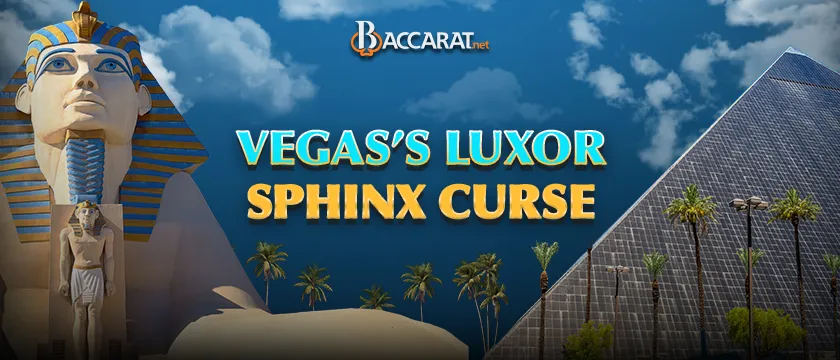Orienting the Luxor’s Sphinx in Las Vegas

One of the reasons that you may occasionally choose to switch from online baccarat to casino baccarat is the desire to enjoy some scenery. Of course, the quality of the scenery varies depending on where you are, but there is little doubt that in places such as Las Vegas, it is pretty spectacular.
One of the most iconic views on the Strip is the Luxor’s enormous Sphinx statue. However, many people seem to wonder if the Sphinx in Vegas is facing the wrong direction, which angers the ancient gods and brings players bad luck.
The origins of this belief are straightforward. The ancient Sphinx faces east, toward the sunrise, which is a symbolic orientation linked to rebirth and sun worship. The Vegas version, according to the legend, faces west, which is supposedly a snub that explains a number of unhappy events in the resort’s history. However, even the most cursory investigation reveals this to be nonsense.
Origins of the Sphinx Statue in Las Vegas
The Las Vegas Sphinx faces due east. That’s the same orientation as the original in Egypt. You can verify this by standing at the Luxor’s east-facing entrance and looking directly at the statue’s line of sight, or simply by looking up a satellite view online, which shows the resort fronting the Strip.
As the belief is so easily dispelled, it raises the question: where did the confusion start?
The Luxor opened in the early 1990s as part of the efforts of then-owner Circus Enterprises to build highly themed properties that would attract families. Early plans didn’t always show the Sphinx; the statue arrived in later design iterations, and its inclusion was simply about visibility. A 110-foot statue facing the Strip is sure to attract traffic and footfall. If it faced away from Las Vegas Boulevard, far fewer people would see it.
However, over time, unrelated incidents became part of the story. A construction worker, Steven Yandell, died in December 1992 after a boom struck him during the build. In September 1996, a guest died by suicide after jumping from an interior balcony. In May 2007, a motion-activated pipe bomb exploded in the parking garage, killing employee Willebaldo Antonio. There is no doubting the tragedy of each of these, but they were separate in cause, and there is no link between them and the statue.
Where the Myth Came From
The origins of urban legends are always fascinating. Often, they truly catch on when they directly relate to imagery that people already recognize. The pyramid shape of Luxor, its torch-lit interiors, and themed rides give people several “ancient mystery” cues. As ever in the modern world, social media is also partially responsible. A recent video doing the rounds on Facebook repeated the direction claim and suggested the gods were displeased.
The Nile River Ride often gets dragged into the tale as supposed proof of paranormal problems. The ride, which consists of flat-bottom barges circling the casino floor, operated from its opening in 1993 until 1996. It was then removed, which rumor mills presented as a response to “apparitions” and “creepy” happenings. However, the truth is less dramatic and more typical of large resorts: low ridership and operational headaches. The attraction interrupted guest flow and underperformed the space it occupied. Removing it streamlined casino traffic and freed up square footage for uses with better revenue potential.
Another source of confusion is the property’s position on the west side of the Strip. The boulevard runs roughly north to south. The Luxor’s main entrance faces across the roadway to the east. Visitors approaching from the Strip naturally see the Sphinx facing them. A quick glance at site plans or aerial photos confirms this.
Finally, size comparisons also play a part. People hear the Vegas Sphinx is taller than the original and jump to symbolism. The Las Vegas figure stands about 110 feet tall, roughly 40 feet taller than estimates for the Great Sphinx of Giza. The point wasn’t to outdo Egypt. It was to scale a front-of-house icon to highway sightlines, pedestrian perspectives, and the volume of Las Vegas Boulevard.
The Basic Facts
Ultimately, if you remove mysticism from the equation, you’re left with three clear facts.
First, orientation: the Luxor Sphinx faces east. That aligns with the Great Sphinx of Giza and undercuts the premise that a westward gaze has put the hotel at odds with ancient beliefs. The “wrong way” claim is factually incorrect.
Second, the incidents cited by storytellers are real, yet causation is being assigned based on theme rather than evidence. Construction accidents, guest tragedies, and criminal acts have occurred at properties of all styles. Constructing a single supernatural narrative is tempting; however, it does not hold up when causes are examined case by case.
Third, design choices at the Luxor reflect late-20th-century resort strategy more than esoteric symbolism. The Sphinx was added for brand impact and visibility. The Nile River Ride was removed for practical reasons. The pyramid, atrium, and exterior features were engineered to create a memorable arrival, drive foot traffic, and support a growing portfolio of entertainment and hospitality offerings.
This is to conclude the debate if the Sphinx in Vegas is facing the wrong direction. Therefore, next time you are in Las Vegas, taking a break from the baccarat tables, you can admire the spectacular view of the Sphinx, safe in the knowledge that it will not damage your luck in any way whatsoever.



